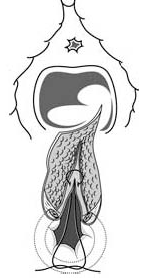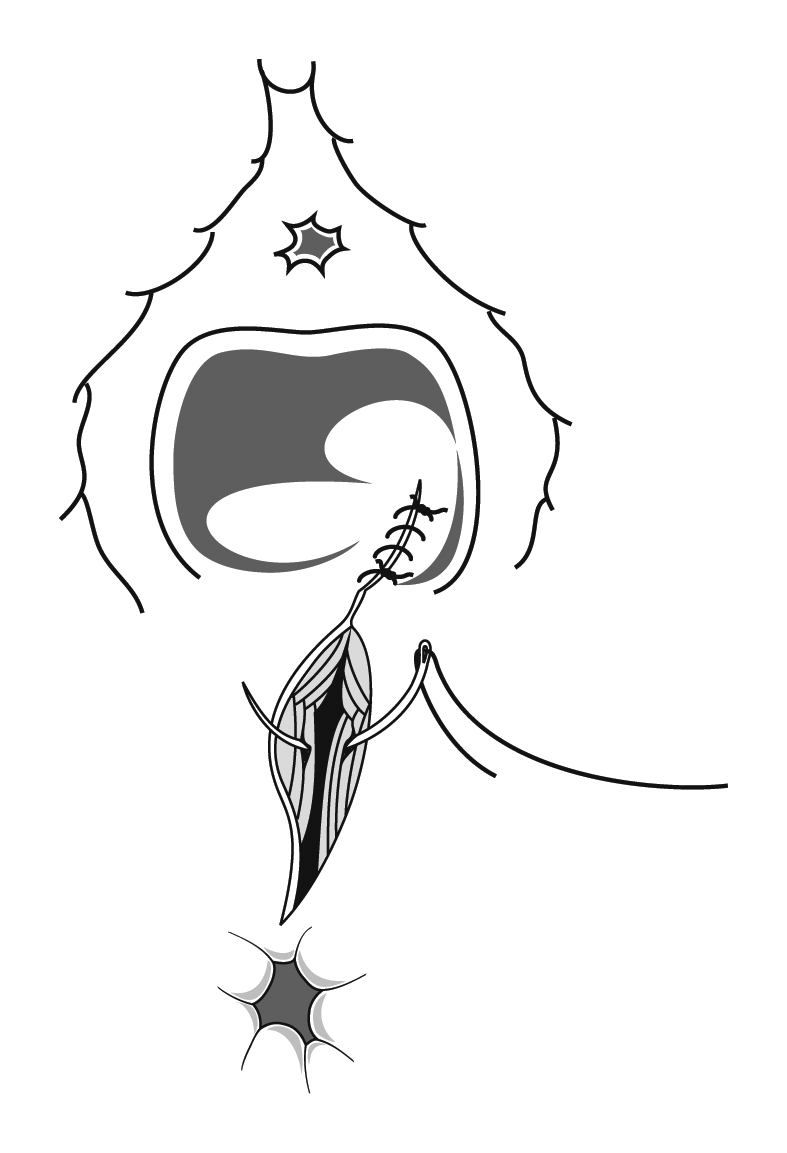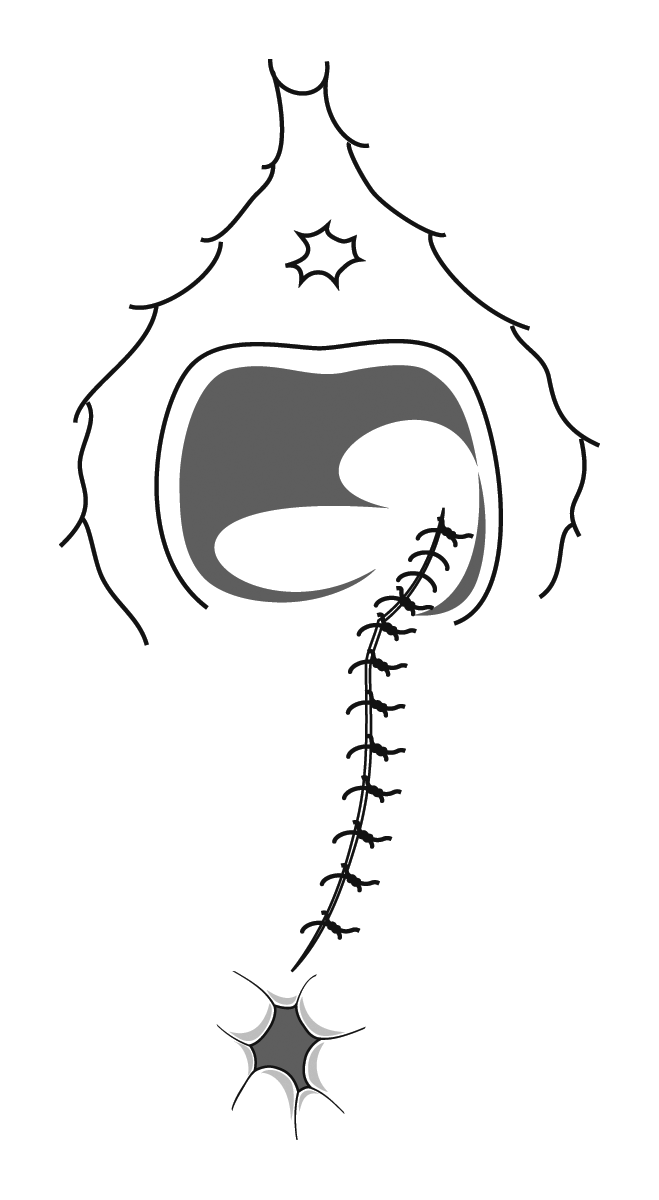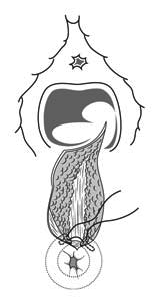During delivery the perineum can tear causing different degrees of vulvovaginal lacerations: superficial (first-degree tear), or deeper, affecting the muscle tissue (second-degree tear, equivalent to an episiotomy).
Two adjacent tissues may also be damaged:
- The anal sphincter muscle, which is red and fleshy. A tear in this sphincter can be recognized by the loss of the anus' radial appearance (third-degree tear). Repair of the muscle is essential to prevent faecal incontinence.
- The rectal mucosa, which is smooth and whitish, extending from the anus. A tear in rectal mucosa (fourth-degree tear) must be sutured to prevent anal fistula with incontinence and infection.
All genital mutilations – that is, clitoral circumcision (Type I mutilation), clitoral circumcision with removal of the labia minora (Type II mutilation), and infibulation (Type III mutilation, Section 5.10) – are associated with a risk of perineal tears during expulsion.
5.9.1 Equipment
- Suture set containing sterile scissors, dissecting forceps and needle holder
- 10% povidone iodine
- 1% lidocaine
- One or two Dec 3 (2/0) absorbable sutures
- A rapidly absorbable suture for closing the skin or, if not available, a non-absorbable Dec 3 (2/0) suture
- Sterile drape and gloves
- Good lighting
5.9.2 Technique
The perineum should not be sutured until after the placenta is delivered.
- Swab the perineum and vagina with povidone iodine 10%.
- Position a sterile aperture drape. Make a tampon from sterile compresses, to be inserted into the vagina to absorb the intra-uterine bleeding while suturing (caution: do not forget to remove them after finishing sutures).
- Assess the size and number of tears. If episiotomy was performed, check to make sure it did not tear further, and look for other tears. If necessary, use vaginal retractors to expose the entire vaginal wall.
- Use local anaesthesia (lidocaine 1%) in all the involved tissues except the rectal mucosa. For complex and/or third- or fourth-degree tears, do the suturing in the operating theatre under general or spinal anaesthesia.
Superficial vulvar tears (first-degree)
- If they are not bleeding and confined to the area near the vaginal opening: basic care, no suturing.
- If they are bleeding or deep: simple continuous or interrupted suture using absorbable suture material.
Episiotomy or simple second-degree perineal tears (second-degree)
- Locate the apex of the cut/tear and place a first stitch there.
- Suture the vaginal mucosa going from the inside out, to just behind the hymenal remnants, using a continuous or interrupted figure-of-eight absorbable suture; stitches should be close enough to prevent lodging of lochia in the following days, but not too deep, to avoid going into the rectum (Figure 5.23).
- Next, suture the muscle layer with 2 or 3 absorbable figure-of-eight sutures (Figure 5.24) or continuous suture.
- Close the skin with rapidly absorbable or non-absorbable suture material, using interrupted (simple or vertical mattress) stitches; begin by placing the first stitch, without tying it, on the posterior commissure (Figure 5.25). Because the tissues will be oedematous in the days following the birth, avoid tying the knots too tight. Continuous subcuticular suture using absorbable suture materials is also possible.
- Perform a rectal examination to make sure that no stitches can be felt in the rectum. Remove compresses from inside the vagina.
|
Figure 5.23 - Suturing the mucosa |
Figure 5.24 - Suturing the muscle |
|
|
|
Rupture of the anal sphincter (third-degree)
- Administer an antibiotic prophylaxis (cefazolin IV 2 g + metronidazole IV 500 mg single dose).
- A tear in the muscular ring can result in retraction of the 2 torn ends of the muscle, now hidden in the tissues. Insert a finger into the rectum to locate the 2 ends.
- Suture the sphincter with 2 or 4 absorbable horizontal mattress sutures (Figure 5.26).
- Continue in the same sequence as in the preceding case.
Figure 5.26 - Suturing the anal sphincter
Tear in the rectal mucosa (fourth-degree)
- Administer an antibiotic prophylaxis (cefazolin IV 2 g + metronidazole IV 500 mg single dose).
- Protect the wound from faecal material by placing a compress in the rectum (as with the vaginal tampon, do not forget to remove it).
- Suture the rectal mucosa, going from high to low, using absorbable, interrupted stitches (Figures 5.27).
- Continue in the same sequence as in the preceding case.
| Figures 5.27 - Suturing the rectal mucosa | |
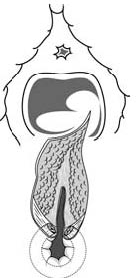 |
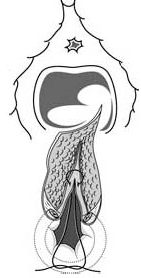 |
5.9.3 Post-operative care
- In all cases, the vulva should be cleansed with soap and water and dried when the patient urinates or defecates, at least 2 times daily.
- For non-absorbable sutures: remove the stitches between the 5th and 8th day.
- Routine analgesia: paracetamol and/or ibuprofen (especially if there is perineal oedema). See Appendix 7.
- For third- and fourth-degree tears, a laxative may be given to prevent passage of hard stools over the sutured rectal mucosa.
5.9.4 Management of complications
Haematoma
- Remove the stitches and drain.
- If there are no signs of infection and the bleeding has stopped, re-suture the episiotomy either completely or partially (to allow spontaneous drainage), or leave a drain in place.
Infection
- Remove the stitches, drain and, if necessary, remove necrotic tissues
- In the event of minor infection: no antibiotic; drainage is enough.
- In the event of severe infection: antibiotherapy for 5 days:
amoxicillin/clavulanic acid PO
Ratio 8:1: 3000 mg daily (2 tablets of 500/62.5 mg 3 times daily)
Ratio 7:1: 2625 mg daily (1 tablet of 875/125 mg 3 times daily)
or
amoxicillin PO: 1 g 3 times daily + metronidazole PO: 500 mg 3 times daily
